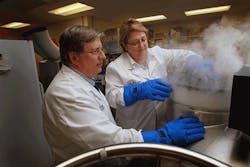Climate Change: The 411 on Indoor and Outdoor Occupational Climate Exposure
When it comes to climate exposure, the most common issues arise from extreme heat and extreme cold and both can be serious workplace concerns.
Heat – High-temperature work environments can elevate the core body temperature. Rising body temps become even more likely the harder a person works. For an outsider looking in, conditions might appear tolerable, but for a worker who has been on the job for an extended period of time, extreme heat could be deadly.
Heat puts strain on a person’s heart and entire cardiovascular system by forcing it to work overtime to support the body’s natural cooling systems. Heat also dehydrates a person at a much faster rate.
Heat-related stress also can be a physical and mental strain. As the body becomes fatigued from heat, it gets clumsier. The risk of workers becoming less attentive and more prone to mistakes increases. The potential for catastrophic harm rises.
Cold – From hypothermia to frostbite, cold carries significant risks when not taken seriously. Temperatures don’t even need to fall below zero for cold-related health risks to emerge.
Cool temperatures or conditions that force a worker to be damp or wet for an extended period of time can result in serious health problems or injury. As a person gets colder, the body begins to draw heat inward, leaving skin and extremities to fend for themselves: Once a person is exposed to harmfully cold conditions, the health and safety risks escalate quickly.
Contrary to some perceptions, the risks of climate exposure are not limited to outside workers:
Indoor hazards – Foundries and other manufacturing facilities can be incredibly hot. Likewise, certain laboratories, cold storage operations and certain areas of food-processing plants are operated at freezing temperatures.
Outdoor hazards – Potentially hazardous situations include construction sites, farms or even city streets. This includes relatively low-stress work that occurs outside, such as a delivery person, mail carrier, etc.
What Can Be Done to Minimize Risk?
The old adage that an ounce of prevention is worth a pound of cure is apt when it comes to extreme climate exposure. It is crucial to understand the risks and know how to stay ahead of dangers.
OSHA says anything bordering a person’s natural body temperature is too hot. Conditions that top 103 degrees Fahrenheit carry a high risk and require aggressive, protective measures. OSHA recommends using air conditioning and ventilation whenever possible; and for inside and outside work, workers should be required to take frequent breaks and drink plenty of water.
Regarding cold, OSHA guidelines are less specific, as different regions are accustomed to different degrees of cold. However, OSHA recommends keeping workers dry, warm and out of the wind whenever possible. As with protection from heat, workers should take frequent breaks to allow their body temperature to recover.
Why Should You Be Proactive?
Businesses that require employees to work in extreme environments need to protect employees from heat and cold dangers. These precautions have business implications, including liability and productivity. As an employer, you may be liable for failing to protect the safety of your workers. Workers under strain from climate exposure will not work as effectively, which means your productivity suffers.
About the author: Travis Mai is the eCommerce sales and training manager at CURT Manufacturing. Curt Manufacturing is committed to workplace safety and owns/operates 10 warehouses in the U.S. and Canada.
